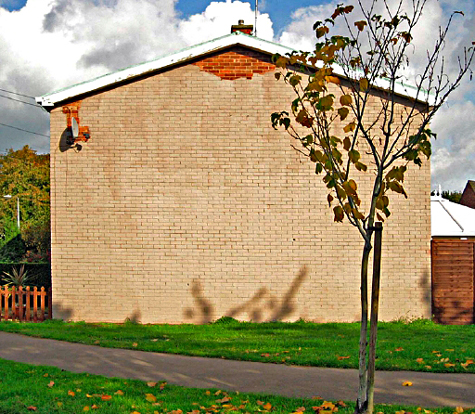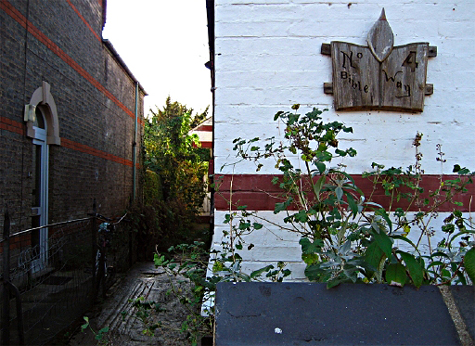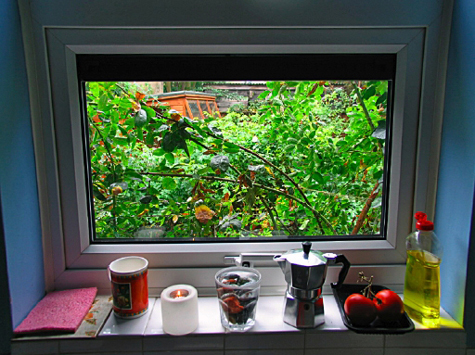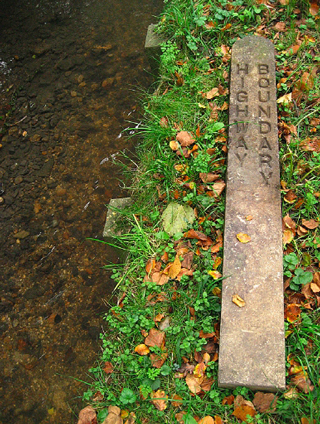Human Flower Project
Shooting an Elephant
For all you photographers, travelers and misc. flaneurs: How to kick the windmill habit, one click at a time.

Amersham
Photo: John Levett
By John Levett
There is a group of which I am a member which concerns itself with urban spaces, their communities, cultural change within them and documentation of their present and their evolution. We come together each month, share current work, digress into the hinterland of theory and speculation and welcome insights into our work that we’d never have considered. We part, go home and bang on with the stuff, closer to our next birthday but happier for the meetup.
Last night’s meet took in Birmingham city centre and referenced Boston City Hall, the American suburbs, European modernism, Guy Debord and Frank Lloyd Wright, inner-city thoroughfares in Sri Lanka, art and representing the political, text images of ex- and sub-urban shopping complexes and ad hoc roadside ‘gardens of remembrance.’

Milton
Photo: John Levett
The best part of our group is that we share the knowledge that everything is in flux, that what is truthful for us last Wednesday will have morphed into a new present by next month. The weight that we each give to each of the multiple variants of the urban experience is unique but it’s intriguing when we take the opportunity to interpret a common urban space. This is what we have been engaged in singly and collectively, on and off, since last year in the Elephant and Castle area of South London.
It’s a neighbourhood known to Chaucer and the Canterbury Pilgrims, to the Elephant Boys Gang, to Saturday night teds, to cyclists of the 1950s on their way out to the south London of Lewisham, Denmark Hill and to Baptists. I always knew it as the way to somewhere else, passed through and rarely halting. I got nicked for speeding through it on my first motorcycle, negotiated its roundabouts and multiple exits for two years in my first teaching job travelling from Bromley to Watford and back daily, spent one Summer vacation working in the Erno Goldfinger-designed government Department of Health now refurbished as pay-as-you-expect-to-earn bijou pods.

Mill Road
Photo: John Levett
It’s now arrived at iconic status due to the current and projected demolition of those parts of it that have stood since its last ‘regeneration.’ Suddenly it’s everybody’s joy and the babe of the Highgate-Hampstead dinnerati (who can glimpse it on a clear day from their safe heights of north London ): “Darling, it’s so convenient for the South Bank.” The remembrance of its status as the waiting room for the alienated masses of Thatcherite-forced unemployment is shunted off to the annex.
A small show of the work that has arisen from our ins and outs at the Elephant opens in a couple of week’s time curated by two of the group. It all arose from a question of how one photographs materiality. We’re all still in progress. My own work has evolved from my conception of the place as an experience of movement to and movement away: the Elephant as a place of passage. My work has concentrated on the experience of process and procession and through that to detour and the making of a space by walking through it.
 Letchworth Garden City
Letchworth Garden City
Photo: John Levett
Georges Perec wrote a book called “An Attempt at Exhausting a Place in Paris.” In it he spends the weekend in cafes in Place Saint-Sulpice recording “what happens when nothing happens” in detail. I have much sympathy for this by way of walking detouring, digressing, deviating but creating afresh a place by referencing it in alternative ways.
A few years ago a friend asked me to photograph the passage ways of Cambridge. Not all of them, just the ones that could pass as distinguished, ancient, redolent of the name Cambridge to the non-resident. There
was a convoluted reason for this, involving an inkling of an idea for a possible-maybe-sometime-over-the-rainbow art project that had come to him in an epiphanic moment whilst meditating, he being of the transcendental party and brooking no suggestion that he might get up off his arse and give it a bash himself, me being of the more radical I’d-rather-eat-maggots-than-snap-passageways tendency.
However, having grown up with the belief that if I said ‘Yes’ and did good things for others then I’d accumulate moral capital that I could cash in on the day I was brought to account, I said ‘Yes’ whilst wondering why I still needed to do this yea-saying being in or around my sixtieth year and should have outgrown that sort of malarky. But the way to progress is always to start and see where things lead.
Passageways were indeed boring so got done and then dumped. There is a way of walking around Cambridge that tends to the routine. It’s a very small place, it’s very dense and it’s got something well-photographed at every turn and it’s surrounded by common land. It makes for a neat city and maybe accounts for the massive tourist trade—everything you need and miss nothing in the length of the working day.
 Newnham
Newnham
Photo: John Levett
‘Miss nothing’ is an hyperbole. You’d miss the bits that go in the ‘Unknown Cambridge’ addendum. Not necessarily because they’re word-of-mouth knowledge-based but often because they’re unresearched. I’ve often thought that I could make a small additional income by publishing a series of walks —The Wittgenstein Promenade, The Plath-Hughes Marathon, The Lytton Strachey Stutter, The Crick-Watson Sprint, The Anthony Blunt Amble—the crannies unsought.
Walking home turf is good practice for photographers. It forces you to notice more, pay attention, change the dominant mode of moving. Detouring is how one defines a place; it exposes the interstices of a space by seeking the unnoticed and ignored—what’s in a basement, what’s on a roof; what’s underfoot, what behind a fence; who’s standing still, who in the moment of an action.
The Passageway Walk, I remember, took me out to Grantchester Meadows and beyond. I say ‘remember’ which is a cheat because I was recently freeing-up disk space and trawling through folders of images of more than a decade ago. This is, of course, fatal if you’ve got owt else planned for the next hours (days?).
From the images I took on that day, it’s very clear that I soon got bored, which is no sort of recommendation for this essay but stay around. The state of boredom is crucial in photography; it means that you’re in the safe zone. You’ve begun your walk and you’ve started snapping and you’re drawn to that which starts you off—the familiar, the warm-up exercise. You come across a likely building and snap; you know how to photograph buildings, you know the angles, the parallels, the convergences, how to kick people out of the shot. Blaze away. There’s a saying in therapy: “Keep doing what you’ve always done and you’ll keep getting what you’ve always got.” That’s why some photographers are found drowned in their developing tanks surrounded by half-processed images of their ten-thousandth windmill. “My name is John Levett and I photograph windmills.” It only takes one day at a time to kick the windmill habit. But you’ve got to want to kick it.

Kitchen View
Photo: John Levett
Start with the sub-conscious click sprint. There’s such a thing as ‘the sub-conscious click.’ You click the shutter on anything that takes less than a blink to think about it. Don’t think, just click and move and the faster the better; the emphasis being on the not thinking. Along with not thinking, walk backwards and sidewards and sitting and squatting. Don’t wait; don’t compose.
The purpose of this is to go along a different path. This is difficult for anyone working (full-time, part-time, any-time) in any art. You do things and feel happy; you share your things and get approval; you’re encouraged and emboldened and you go public; your bounty is magnified. Get to that point and change becomes scary; others have expectations of you; their disappointment might show—not directly but you might detect a certain hesitancy (“I’ll be interested to see how you’re new series develops. In the long term. Keep me in the loop.”). You wake in the night and it’s worse (Clement to Jackson: “Sorry Jack. You’ve lost it.”). Staying with your change is the thing to do. Trust it and it leads elsewhere. Miles Davis had the idea. He knew when the band had gone as far as it could. He broke it up, started again, every start leading elsewhere. Same with Coltrane—go somewhere new and get all the ideas out before death.
 The Backs
The Backs
Photo: John Levett
Which leads me to this newsletter that I write for The Human Flower Project. This is my half-century of posts to the Project since I became a regular and I’m staggered that I still have something to say even if it’s banging on about Orwell and Letchworth, Larkin and the quotidian (or almost-ineffable), Vita and roses, Jack Harkness and Hitchin.
I’ve come to saying to myself daily “You’re going to die.” I’ve got my eye on 2025. That’ll make me eighty-one. Dying before eighty signifies a lack of ambition; kicking in for an additional year gives time to sort stuff. I came off my bike a month or so ago whilst trying to prove that I was closer to nineteen than ninety. I came off trying to bunny-hop from the road onto a cycle path but conveniently only four hundred metres from Addenbrookes Hospital Accident and Emergency department. A very nice couple stopped to offer help; he pushed my bike to the hospital and she drove me round to the front door. Nothing broken, dislocated finger, hip swelling the size of a rugby ball and skin tears. I’m practicing hard to be the cyclist and abandon (in practice) the boy racer, investing in the future. Accepting death, sooner or later, means for me permanent revolution in the sense of continual creation. It’s wearing me out. Still time (theoretically) to fit in the next fifty.
Editor’s note: John Levett, met online in an argument over the (de)merits of Constance Spry, has generously contributed articles to Human Flower Project for half a decade, not half a century. Time creeps when you’re detouring. Thank you for birthing us, John.

